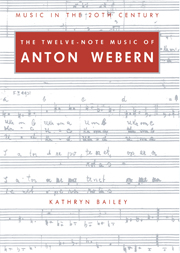Book contents
- Frontmatter
- Contents
- Acknowledgements
- Conventions in the text
- Introduction
- PART I Row and canon
- PART II The instrumental music
- PART III The music with voices
- Conclusion
- Appendices
- I A comparison of row characteristics
- II Matrices
- III Row analyses (1)
- IV Row analyses (2)
- V A note on Webern's graces
- Notes
- Glossary
- Chronological worklist
- Select bibliography
- Index
I - A comparison of row characteristics
Published online by Cambridge University Press: 23 December 2009
- Frontmatter
- Contents
- Acknowledgements
- Conventions in the text
- Introduction
- PART I Row and canon
- PART II The instrumental music
- PART III The music with voices
- Conclusion
- Appendices
- I A comparison of row characteristics
- II Matrices
- III Row analyses (1)
- IV Row analyses (2)
- V A note on Webern's graces
- Notes
- Glossary
- Chronological worklist
- Select bibliography
- Index
Summary
This table lists the intervallic and combinatorial properties of all the rows used in Webern's published works. The following information is given for each row:
column 2:
the intervallic content of unordered hexachords in terms of semitones (the numbers represent the interval succession when the contents of the hexachord are arranged in ascending order, in closest position – Forte's ‘best normal order’, or its inversion, where this is applicable). The numbers in parentheses represent the distance between last and first notes of the hexachord. These numbers are placed at the end of hexachords that correspond directly to pitch–class sets, at the beginning of those that represent inverted pc sets. The only exception to this is those rows that consist of two completely chromatic hexachords, which have been represented as 11111(7)/(7)11111 in order to emphasize the inversional relationship of the second hexachord to the first, although in fact the two hexachords are also identical and could be just as accurately represented 11111(7)/11111(7).
column 3:
the combinatorial or symmetrical properties. The hexachordal content of all rows following the sign ≠ is complementary to that of P0; row forms standing on either side of an = sign are exactly identical with respect to order as well as content. Rows with no combinatorial properties are labelled ‘nc’.
column 4:
the row type. Only two of the twenty–one rows are unique in terms of hexachordal content, those of Opp. 17/i and 18/iii. The others are all drawn from six types of combination, identified here with letters indicating frequency of use.
- Type
- Chapter
- Information
- The Twelve-Note Music of Anton WebernOld Forms in a New Language, pp. 335 - 336Publisher: Cambridge University PressPrint publication year: 1991



